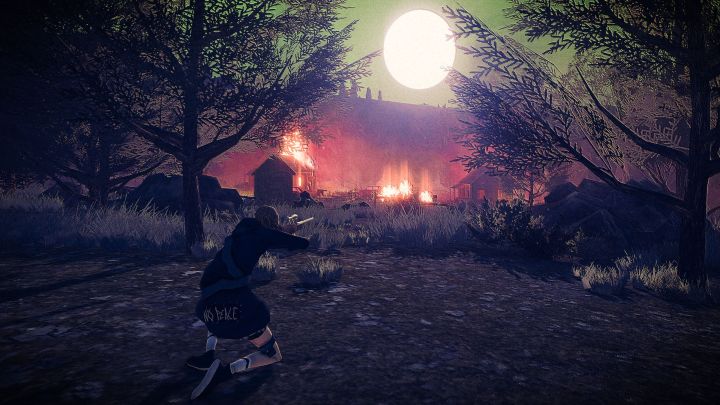- Ingenious puzzle-shooting mechanic
- Haunting visual style
- Unnerving sound design
- Ends as it gets going
- Tired cultist story
In Children of the Sun’s pitch-black world, obsession is an all-consuming vortex that baptizes its victims in blood. It swallows normal people and spits out religious fanatics who believe they need to kill for their god. It transforms a girl into a gun-toting murderer who won’t stop shooting until she’s put a bullet in every single one of those cultists in the name of revenge. There are no righteous crusades here, only bodies.
That’s the tension at play in the latest game from publisher Devolver Digital and developer René Rother. Children of the Sun is a hyper-gritty tone piece with a sickly satisfying sniping mechanic at its heart. Though it explores ideas about video game violence that are well-trodden in 2024, the short puzzle-shooter hybrid is effectively unnerving. The violence is uncomfortable, the harsh soundscape is overwhelming, the visuals are creepy. And yet, I’m drawn to the trigger level after level, desperate to find nirvana in a pile of corpses.
Symphony of blood
When the story begins, I take on the role of a mysterious sniper only known as The Girl. Some quick motion comic cutscenes tease out a mysterious story about a nefarious religious cult dubbed the Children of the Sun, which The Girl has very good reason to hate. She sets out on a path of revenge, vowing to wipe out derelict complexes filled with zealots en route to the group’s leader. That journey happens over around 26 blood-soaked shooting galleries that mount in complexity.
But Children of the Sun is far from a traditional shooter. At the start of each level, I sit at the outskirts of a cultist gathering. Sometimes, I’m watching four zealots camped out by a fire. Other times, I sit outside an outpost as a dozen of them keep watch. Before I fire a shot, I can walk in a circle around the scene by pressing left and right. I can stop to look through my scope and mark a target to track their movements permanently. It almost plays like a twisted hidden object game as I scope out well-hidden cultists.
Every shooting leaves me shaken.
Planning is key because The Girl only has one shot to get it right — literally. The goal of each level is to take out every single target with one metaphysical bullet. The moment the bullet leaves my barrel, my perspective shifts, and I embody that hunk of lead. Each time I hit a target, instantly killing them no matter where I strike, I can re-aim from that point and ping-pong over to another target. Time slows during the entire process, so two minutes of careful movement translates to a few seconds in real time. It’s an ingenious hook in the same vein as Superhot’s time-shooting twist, one that makes me feel like an undefeatable assassin when I enter a level and leave behind a heap of bodies.
The Girl is meticulous in her revenge, and additional twists reinforce that obsession. As my bullet zips through the air, I can hold down a button to slow time and make some slight adjustments to its trajectory. That doesn’t just help ensure that I won’t hit frustrations when I miss a far-away enemy; it lets me enact my vengeance with sick precision. If I want to put a bullet in everyone’s head, I can assure you, that happens. Later, I can target weak points on my enemies to fill a meter that lets me turn my bullet around in mid-air. Those twists allow for some strong spatial reasoning puzzles that have me plotting out a perfect route between targets and directing my bullet like a conductor. It’s a symphony of blood.

While I appreciate Children of the Sun’s focused runtime (it only takes a few hours to beat), it does feel like it comes to a halt just as it’s picking up momentum. It only features a few other mechanical twists – like being able to shoot a bird overhead to gain a top-down view of the level — and there are only a few puzzle-like enemy types that need to be dispatched in specific ways. There’s just enough here to keep each level feeling different enough through the end, like a highway chase scene that has me bouncing between gas tanks, but I’m left wanting a bit more by the time I finish its final challenge.
Perhaps it’s for the best that the story is so short. Children of the Sun wants players to revel in their bloodlust but still feel the enormity of that violence. There isn’t a glut of “content” here that leaves me feeling desensitized to what I’m doing by level 100. Every shooting leaves me shaken; what have I just done?
Tale as old as time
What’s less engrossing is Children of the Sun’s actual story, which plays into tired video game tropes. As I started it up, I realized just how many games I’ve played this year revolve around fighting cults of some kind. Like a Dragon: Infinite Wealth, The Last of Us Part 2 Remastered, and Alone in the Dark are all at the top of that list. It’s well-trodden territory and Children of the Sun can’t really do much with it within its minimalist motion comic cutscenes that feel like they were pulled out of a Garth Ennis comic. I find myself rolling my eyes at a brand of video game edginess that’s grown dull.
Self-reflective meditations on violence-fueled revenge are a dime a dozen …
Children of the Sun is more compelling when simply taken as a hyper-violent tone piece. It has the same unnerving energy present in the films of Jeremy Saulnier, a director known for visceral meditations on violence like Blue Ruin and Green Room. Children of the Sun adopts some oppressive aesthetic choices not unlike those found in Saulnier’s films. It’s a claustrophobic game, right down to the fact that I’m always trapped within a small circle that I can only navigate in two rigid directions.
Haunting visuals sell the discomfort. Children of the Sun features a dark and fractured art style. It’s like I’m looking at the world through a thermal scope, reducing real people to blips of heat to be easily aimed at. Levels are bathed in deep gray and purple, while enemies have a bright golden sheen. They look less like humans than trophies — a reward to be claimed upon successful kill.

The heavy sound design makes me feel even sicker. It’s not so much the crack of a bullet colliding with a skull that makes me jolt each time; it’s the droning electronics that seep into my eardrums. There isn’t so much music here as a chaotic onslaught of distorted synthesizers. They bury the world in a wall of harsh noise; my Steam Deck speakers sound like they’re on the verge of shorting out as peaking audio sputters from them. It’s properly grotesque; the sound is as thick as the blood I’m spilling.
Self-reflective meditations on violence-fueled revenge are a dime a dozen in a post-Last of Us landscape. Children of the Sun doesn’t move that conversation forward in a meaningful way, but it still makes an impact. It’ll leave players obsessing over every tiny detail of their murder spree until they press Quit and sit in jarring silence.
Children of the Sun was tested on PC and Steam Deck.





